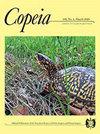陆地蝾螈不同颜色形态间膳食分配的时空评估
IF 2.6
Q2 Agricultural and Biological Sciences
引用次数: 4
摘要
当颜色模式变化与其他生物特征共同适应时,不同的颜色形态可以沿着不同的生态位轴分离,并且关于生态位划分的数据可以提供对不同颜色形态如何在时空尺度上保持的见解。东方红背蝾螈,Plethodon cinereus,包含两种常见的颜色形态(条纹和未成熟),除了颜色外,它们还沿着几个特征轴不同。先前对单个种群的研究表明,膳食组成代表了灰蝶形态之间生态分化的一个重要轴。为了确定形态是否在空间和时间上划分猎物资源,我们收集了六个种群形态的胃内容物,这些种群的颜色形态频率从100%条纹到>99%未成熟,并在春季和秋季对每个种群进行了采样。从每个种群和季节,我们还对落叶无脊椎动物进行了采样,以量化猎物选择中的形态差异。基于之前的研究,我们预测在多态种群中,条纹形态的饮食将由更高质量的猎物组成,而在单形态种群中,我们预测由于形态间竞争的生态释放,两种形态的饮食都将更加多变。在我们检测的两个多态性群体中,一个没有显示出饮食差异的证据,另一个反映了先前研究中报告的差异。多态性和单态群体之间的饮食广度没有变化,因此没有饮食释放的迹象。我们的研究结果表明,饮食无脊椎动物和落叶无脊椎动物之间存在高度重叠,这表明灰蝶的两种形态都是广泛的捕食者。最后,我们发现不同季节和种群的饮食组成不同,这表明了在空间和时间尺度上检查形态特征的重要性。本文章由计算机程序翻译,如有差异,请以英文原文为准。
A Spatiotemporal Assessment of Dietary Partitioning between Color Morphs of a Terrestrial Salamander
When color pattern variation is co-adapted with other biological features, distinct color morphs may be separated along divergent niche axes, and data on niche partitioning can provide insight into how distinct color morphs are maintained over spatiotemporal scales. The Eastern Red-backed Salamander, Plethodon cinereus, contains two common color morphs (striped and unstriped) that differ along several trait axes in addition to coloration. Previous studies from a single population have suggested that dietary composition represents an important axis of ecological differentiation between morphs of P. cinereus. To determine if morphs partition prey resources over space and time, we collected stomach contents from morphs across six populations that ranged in color morph frequency from 100% striped to >99% unstriped, and sampled each population in a spring and a fall season. From each population and season, we also sampled leaf litter invertebrates to quantify morph differences in prey selection. Based on previous studies, we predicted striped morph diet would consist of higher quality prey in polymorphic populations, whereas in monomorphic populations, we predicted both morphs would have a more variable diet due to ecological release from intermorph competition. In the two polymorphic populations we examined, one showed no evidence of diet differences and the other mirrored differences reported from previous studies. There was no change in dietary breadth between polymorphic and monomorphic populations, and thus no signature of dietary release. Our results show there is a high degree of overlap between dietary and leaf litter invertebrates, suggesting both morphs of P. cinereus are generalist predators. Finally, we found dietary composition varied across seasons and populations, which demonstrates the importance of examining morph traits over spatial and temporal scales.
求助全文
通过发布文献求助,成功后即可免费获取论文全文。
去求助
来源期刊

Copeia
生物-动物学
CiteScore
2.10
自引率
0.00%
发文量
0
审稿时长
6-12 weeks
期刊介绍:
Founded in 1913, Copeia is a highly respected international journal dedicated to the publication of high quality, original research papers on the behavior, conservation, ecology, genetics, morphology, evolution, physiology, systematics and taxonomy of extant and extinct fishes, amphibians, and reptiles. Copeia is published electronically and is available through BioOne. Articles are published online first, and print issues appear four times per year. In addition to research articles, Copeia publishes invited review papers, book reviews, and compiles virtual issues on topics of interest drawn from papers previously published in the journal.
 求助内容:
求助内容: 应助结果提醒方式:
应助结果提醒方式:


